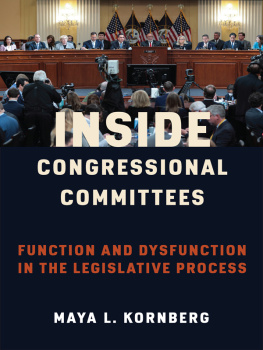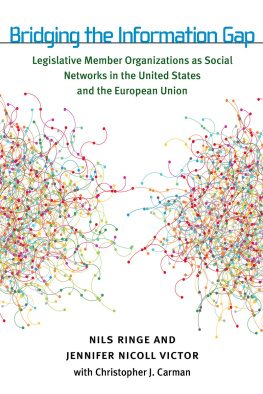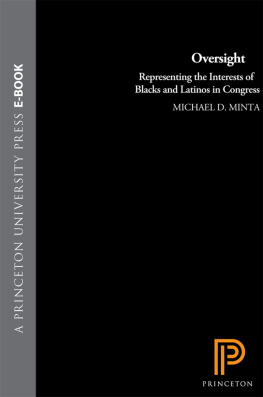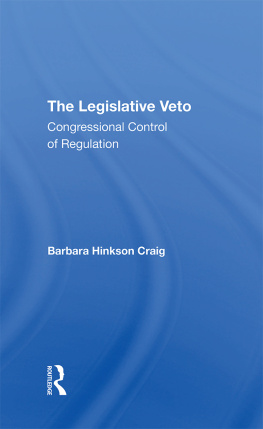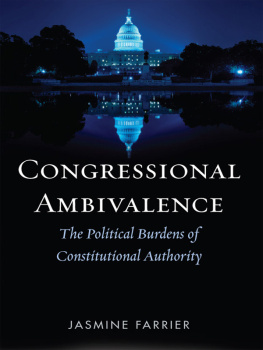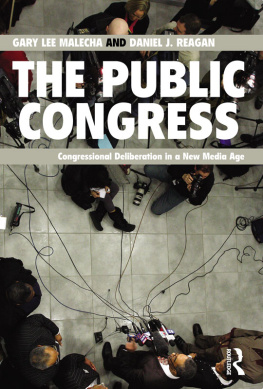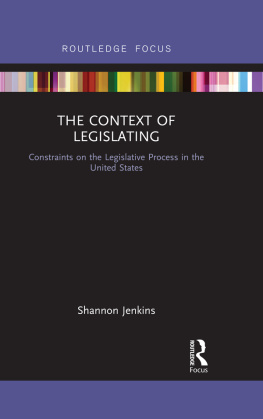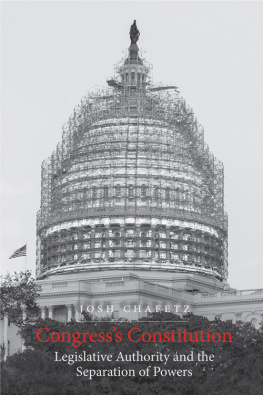Table of Contents
INSIDE CONGRESSIONAL COMMITTEES
INSIDE
CONGRESSIONAL
COMMITTEES
FUNCTION AND DYSFUNCTION
in the
LEGISLATIVE PROCESS
MAYA L. KORNBERG
Columbia University Press
New York
Columbia University Press
Publishers Since 1893
New YorkChichester, West Sussex
cup.columbia.edu
Copyright 2023 Columbia University Press
All rights reserved
EISBN 978-023-155428-2
Library of Congress Cataloging-in-Publication Data
Names: Kornberg, Maya, 1991- author
Title: Inside congressional committees : function and dysfunction
in the legislative process / Maya L. Kornberg.
Description: New York : Columbia University Press, [2023] |
Includes bibliographical references and index.
Identifiers: LCCN 2022025712 (print) | LCCN 2022025713 (ebook) |
ISBN 9780231201827 (hardback) | ISBN 9780231201834 (trade paperback) |
ISBN 9780231554282 (ebook)
Subjects: LCSH: United States. CongressCommittees. |
Legislative hearingsUnited States.
Classification: LCC JK1029.K67 2023 (print) | LCC JK1029 (ebook) |
DDC 328.73/0765dc23/eng/20220815
LC record available at https://lccn.loc.gov/2022025712
LC ebook record available at https://lccn.loc.gov/2022025713
A Columbia University Press E-book.
CUP would be pleased to hear about your reading experience with this e-book at .
Cover image: Sipa / AP Images
TO MY PARENTS, FOR THEIR CONTINUAL
FAITH AND CEASELESS SUPPORT
Contents
I would like to acknowledge the support of those who made this book possible. Inside Congressional Committees: Function and Dysfunction in the Legislative Process is based on previous research completed in 2019 at Oxford Universitys Department of Politics and International Relations, under the supervision of Professor Desmond King. The institutional, financial, and academic support therefore also formed a base for this book.
This book would not be possible without the many interviewees who graciously volunteered their time and insights. I am indebted to them for taking part in the research. I would also like to thank my friend Amir Malka, whose generous help with coding proved invaluable to the data collection process.
I owe a debt of gratitude to Desmond King, Nigel Bowles, and Sven Siefken for their valuable comments and suggestions on the manuscript. Their early feedback greatly strengthened the book.
I am also grateful to Stephen Wesley and Columbia University Press for the continuous support throughout the process.
To my dear friendsSarah, Lili, Elle, Marta, Keren, Corinne, my brothers, and the many other voices of encouragement along the waythank you for your friendship.
I am thankful for my family, near and far, for their presence and inspiration.
And to Noam, thank you for brightening my days and my writing process.
Society is a living organism and must obey the laws of life, not of mechanics; it must develop... a nation is a living thing and not a machine.
Woodrow Wilson, 1912
W ilson saw a country in a state of evolution. Inside Congressional Committees: Function and Dysfunction in the Legislative Process rests on the assumption that Congress, the legislative core of American society, acts as a living thing rather than a rulemaking machine. As the American nation changes and develops, so too does its legislative center. Scholars of historical institutionalism Stephen Skowronek and Karen Orren write that to create something new in politics is, in the nature of things, to displace institutions. And these displacements accumulate over time, magnifying distances and departures from points of origin. This book explores congressional committees today after centuries of displacement and evolution.
Signs point to a contemporary Congress in which displacements have stirred increased partisanship and reduced legislative productivity. In an analysis of roll call voting that extends back to 1789, political scientists Keith T. Poole and Howard Rosenthal showed extremely high levels of polarization in Congress, almost as high as it was during and immediately after the Civil War. They also looked at attendance for division votes (in which members receive no prior notice) as an indication of attendance at debates and found declining turnout as well as fewer speakers in attendance. Their study points to a marked decline in deliberation. In their 2006 book, The Broken Branch, scholars of Congress Thomas Mann and Norman Ornstein portray a Congress crippled by the filibuster and partisan gridlock. Congress is passing fewer laws, spending less time legislating and deliberating, and increasingly constrained by party lines.
What has made Congress impotent? Inside Congressional Committees focuses on committees as an important part of the story. Once a center of congressional power and bipartisanship, congressional committees slowly lost their power as Congress declined. Nonetheless, they still form a legislative concourse leading up to bill passage and account for a significant portion of legislators schedules. This book peeks under the legislative hood. It examines the purpose and procedure of contemporary congressional committees, and follows dramatic changes to committee procedure over the twentieth century that undermine their roles as centers of congressional deliberation, learning, and bipartisanship.
The Decline of Committees: A Century of Reform
In one of the major books on parliamentary committees, legislative studies scholars John Lees and Malcolm Shaw open with the following definition: A committee is a body to which some task has been referred or committed by some other person or body.... There is inherent in the notion of a committee some idea of a derived... nature... it acts on behalf of or with responsibility to another body. Hamilton observed.
In the contemporary Congress, the Senate and House of Representatives have twenty-one and twenty standing committees, respectively. Most committee jurisdictions are divided based on policy issues, although a minority of committees focus on procedural issues (e.g., House Rules Committee).
The survey of committee history in Inside Congressional Committees originates at the beginning of the twentieth century, when a dramatic shift in the power and function of committees began. The first half of the twentieth century was marked by the strengthening of committees and the deepening of their expertise. As a result of the 1910 Cannon revolt, in which Republican representatives joined the Democratic minority (hard to fathom today) to overthrow Speaker Joseph Cannon (R-IL), known as the czar, committees gained legislative power and autonomy. Early that year, the formidable progressive Democrat, Representative Oscar Underwood, framed the struggle as follows: We are fighting a system, and that system is the system that enables the Speaker, by the power vested in him, to thwart and overthrow the will of the majority membership of this House.back the House in 1911, the Speaker lost his power over committee assignments. This gave rise to a system in which member seniority (rather than the personal preferences of the Speaker) prescribed committee chairmanship. These two years were a turning point. This change gave committees greater autonomy because power filtered down from the party leadership directly into the hands of committees.

